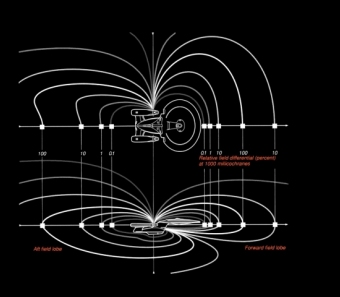|

One of the most fundamental concepts in Star Trek is
that of subspace. In the Star Trek world, subspace is an integral part
of the space-time continuum - a distinct dimension in space, yet
coexistent with 'normal' space. Subspace and normal space are
confluenced together. It is the feature of space-time which facilitates
faster-than-light transit, in the form of interstellar travel and the
transmission of information almost instantaneously over long distances.
Many spatial anomalies and astrophysical objects in Star Trek can be
found in subspace or be formed in normal space by it. Subspace
apparently has an infinite number of domains. Geordi La Forge compared
it with "...a huge honeycomb with an infinite number of cells". (TNG:
"Schisms").
Exactly what subspace is has never been explicitly
revealed on screen in Star Trek. This is not surprising since it is
used as a solution and cause of various normally insurmountable
problems throughout the series.
Unfortunately, there is no real astrophysical concept
actually called subspace. The term 'subspace' is mostly used in
mathematics. In linear algebra, a Euclidean subspace (or subspace of
Rn) is a set of vectors that is closed under addition and scalar
multiplication. Geometrically, a subspace is a flat in n-dimensional
Euclidean space that passes through the origin. Examples of subspaces
include the solution set to a homogeneous system of linear equations,
the subset of Euclidean space described by a system of homogeneous
linear parametric equations, the span of a collection of vectors, and
the null space, column space, and row space of a matrix. In topology
and related areas of mathematics, a subspace of a topological space X
is a subset S of X which is equipped with a natural topology induced
from that of X called the subspace topology (or the relative topology,
or the induced topology, or the trace topology).
However, something akin to subspace or faster-than-light
communication might be possible if a theory reported by Fabrice Petit
of the Belgian Ceramic Research Centre and Michael Sarrazin of the
Facultés Universitaires Notre-Dame de la Paix, in Belgium, in
September 2007 in the journal Physical Review D, proves to be true.
These researchers describe what amount to shortcuts through extra
dimensions.
Petit and Sarrazin, inspired by string theory, describe
a situation in which the universe we know is actually just one sheet or
brane in a higher dimensional spacetime. In this model of reality, our
universe includes a second sheet that we're not normally aware of
because we're confined to our own sheet. Petit and Sarrazin describe a
specific "braneworld" scenario in which there are just these two
branes. In this case, although particles can't exist between branes,
they can travel back and forth between the sheets by way of quantum
mechanical tunneling, which allows passage across barriers that
classical physics considers insurmountable. Under the right
circumstances, a powerful magnetic field can cause a particle to
oscillate between the two branes. If the other brane is warped in a
certain way, distances there may be shorter than in our own brane. This
means if a fast-moving particle were made to travel in the other brane
for a while before returning to ours, it could actually get to a
distant part of our universe much faster than a light signal confined
to our brane.
Petit and Sarrazin point out that their theory only
works for fermions – particles that include protons and neutrons, but
not all types of atoms. Since our bodies contain a lot of atoms that
are not fermions, humans could probably never take such shortcuts. But
by making electrons or other fermionic particles take shortcuts through
the other brane, it might be possible to communicate faster than light
speed, just like in Star Trek. Breaking the light speed barrier is
normally thought to be impossible because it allows particles to time
travel, leading to problems with causality – paradoxes that spring up
when effects can happen before their causes. The Petit-Sarrazin
scenario needn't violate causality because the shortcutting particles
get to their destination faster than light only when confined to our
brane. When their path through the extra dimension is taken into
account, they actually obey an overall speed limit, allowing causality
to be preserved.
|
|
